Hotpoint FQ 1030.1 User Manual

Operating Instructions
OVEN
|
|
|
|
|
|
|
|
|
|
|
|
|
|
|
|
|
Contents |
|
|
|
|
|
|
|
|
|
GB |
|
|
|
|
|
|
|
|
|
Installation, 2-3 |
|
|
|
|
|
|
|
|
|
|
|
|
|
|
|
DK |
|
|
|
|
|
|
|
GB |
|
|
NO |
|
Positioning |
|
||
|
|
|
|
|
|
|
Electrical connection |
|
|
|
|
|
|
|
|
|
|
||
|
English,1 |
Dansk, 13 |
Norsk,25 |
Data plate |
|
||||
FI SE
Suomi, 37 |
Svenska, 49 |
Description of the appliance, 4
Overall view Control panel
Start-up and use, 5
Control panel lock
DEMO mode
Setting the clock and timer
Starting the oven
Cooking modes, 6-9
FQ 1030.1 NE /HA
Manual cooking modes Automatic cooking modes Programming the cooking mode Practical cooking advice Cooking advice table
Precautions and tips, 10
General safety Disposal
Respecting and conserving the environment
Care and maintenance, 11-12
Switching the appliance off Cleaning the appliance Cleaning the oven door Replacing the light bulb Assistance
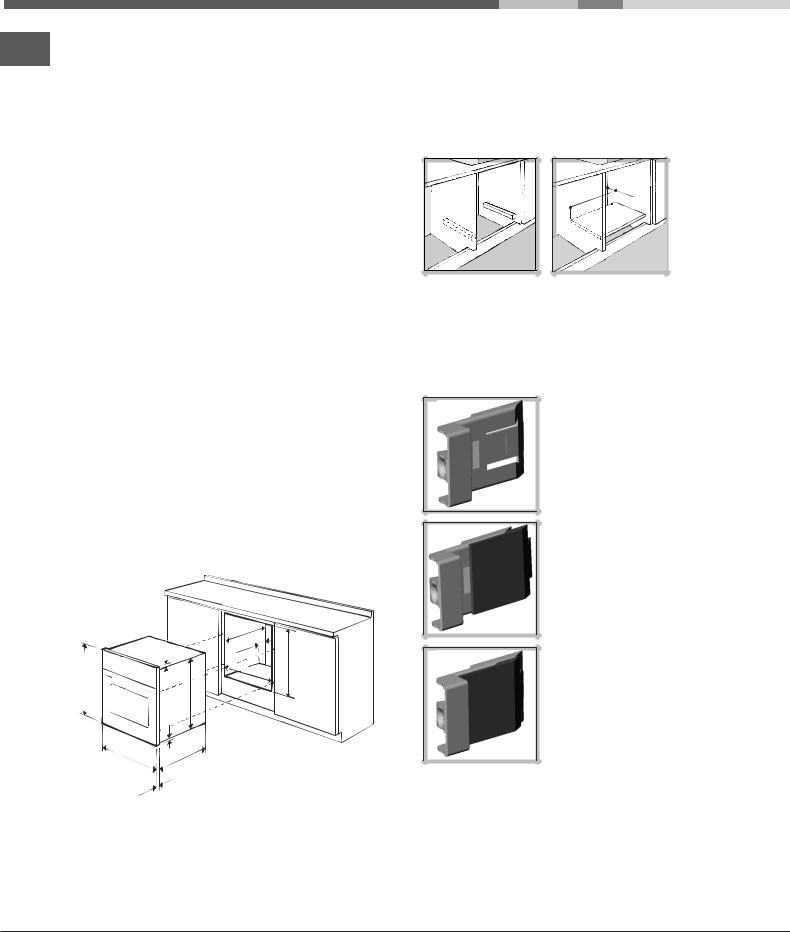
Installation
Before operating your new appliance please read GB this instruction booklet carefully. It contains
important information concerning the safe operation, installation and maintenance of the appliance.
Please keep these operating instructions for future reference. Pass them on to possible new owners of the appliance.
Positioning
Keep all packaging materials out of the reach of children. It may present a choking or suffocation hazard (see Precautions and tips).
The appliance must be installed by a qualified professional in accordance with the instructions provided. Incorrect installation may cause harm to people and animals or may damage property.
Built-in appliance
Use the appropriate cabinet to ensure that the appliance functions properly.
•The panels adjacent to the oven must be made of heat-resistant material.
•Cabinets with a veneer exterior must be assembled with glues which can withstand temperatures of up to 100°C.
•To install the oven under the counter (see diagram) and in a kitchen unit, the cabinet must have the following dimensions:
23 mm. 5 mm.
595 mm.
567 mm.
|
|
|
|
|
. |
|
|
|
|
in |
|
|
|
|
.m |
|
|
|
|
m |
|
|
|
47 |
m |
|
|
|
|
5 |
|
|
|
|
|
|
|
|
|
. |
|
45 |
mm |
|
|||
|
|
|
|
|
|
|
558 |
mm. |
|||
|
|
|
|
||
593 mm.
595 |
|
m |
|
mm. |
. |
|
m |
|
|
|
545 |
|
. |
|
|
m |
|
|
m |
|
24 |
|
|
The appliance must not come into contact with electrical parts once it has been installed.
The indications for consumption given on the data plate have been calculated for this type of installation.
Ventilation
To ensure adequate ventilation is provided, the back panel of the cabinet must be removed. It is advisable to install the oven so that it rests on two strips of wood, or on a completely flat surface with an opening of at least 45 x 560 mm (see diagrams).
. |
45 |
mm |
|
m |
|
. |
|
m |
|
|
|
560 |
|
|
|
Centring and fixing
Position the 4 tabs on the side of the oven so that they are lined up with the 4 holes on the outer frame. Adjust the tabs according to the thickness of the cabinet side panel, as shown below:
20 mm thick: take off the removable part of the tab (see
diagram).
18 mm thick: use the first groove, which has already been set in the factory (see
diagram).
16 mm thick: use the second groove (see diagram).
Secure the appliance to the cabinet by opening the oven door and putting 4 screws into the 4 holes on the outer frame.
All parts which ensure the safe operation of the appliance must not be removable without the aid of a tool.
2
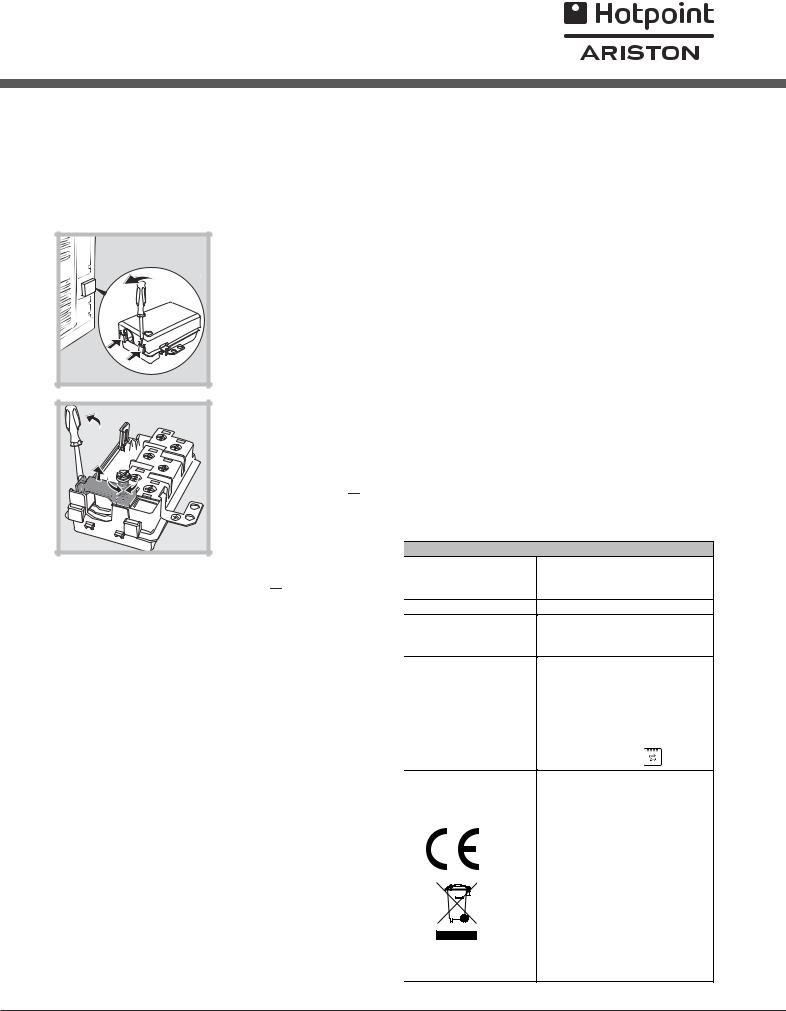
Electrical connection
Ovens equipped with a three-pole power supply cable are designed to operate with alternating current at the voltage and frequency indicated on the data plate located on the appliance (see below).
Fitting the power supply cable
1. Open the terminal
board by inserting a screwdriver into the
side tabs of the cover.
Use the screwdriver as
a lever by pushing it
down to open the cover (see diagram).
2. Loosen the cable clamp screw and remove it, using a screwdriver as a lever (see figure).
3. Remove the wire contact screws L-N-  , then fasten the wires under the screw heads, respecting the colour code: Blue (N), Brown
, then fasten the wires under the screw heads, respecting the colour code: Blue (N), Brown
(L) and Yellow-Green Verde ( ).
).
Connecting the supply cable to the mains
Install a standardised plug corresponding to the load indicated on the data plate (see table). The appliance must be directly connected to the mains using an omnipolar circuit-breaker with a
minimum contact opening of 3 mm installed between the appliance and the mains. The circuit-breaker must be suitable for the charge indicated and must comply with current electrical regulations (the earthing wire must not be interrupted by the circuitbreaker). The supply cable must be positioned so that it does not come into contact with temperatures higher than 50°C at any point.
The installer must ensure that the correct electrical connection has been made and that it is fully compliant with safety regulations.
Before connecting the appliance to the power supply, make sure that:
•The appliance is earthed and the plug is compliant with the law.
• The socket can withstand the maximum power of |
|
|
GB |
||
the appliance, which is indicated on the data |
||
plate (see below). |
|
|
|
•The voltage is in the range between the values indicated on the data plate (see below).
•The socket is compatible with the plug of the appliance. If the socket is incompatible with the plug, ask an authorised technician to replace it. Do not use extension cords or multiple sockets.
Once the appliance has been installed, the power supply cable and the electrical socket must be easily accessible.
The cable must not be bent or compressed.
The cable must be checked regularly and replaced by authorised technicians only (see Assistance).
The manufacturer declines any liability should these safety measures not be observed.
TABLE OF CHARACTERISTICS
|
width 43.5 cm |
|
|
Dimensions |
height 32 cm |
|
|
|
depth 41.5 cm |
|
|
Volume |
58 l |
|
|
Electrical |
voltage: 220-240V ~ 50Hz |
||
maximum power absorbed |
|||
connections |
|||
2800 W |
|
||
|
|
||
|
Directive 2002/40/EC on the |
||
|
label of electric ovens. |
||
|
Regulation EN 50304 |
|
|
ENERGY LABEL |
Declared energy |
|
|
|
|
||
|
consumption for Forced |
||
|
convection Class |
|
|
|
– heating mode: |
Gratin |
|
|
This appliance conforms to |
||
|
the following European |
||
|
Economic Community |
|
|
|
directives: 2006/95/EEC |
||
|
dated 12/12/06 (Low |
|
|
|
Voltage) and subsequent |
||
|
amendments - 89/336/EEC |
||
|
dated 03/05/89 |
|
|
|
(Electromagnetic |
|
|
|
Compatibility) and |
|
|
|
subsequent amendments - |
||
|
93/68/EEC dated 22/07/93 |
||
|
and subsequent |
|
|
|
amendments. |
|
|
|
2002/96/EEC |
|
|
3
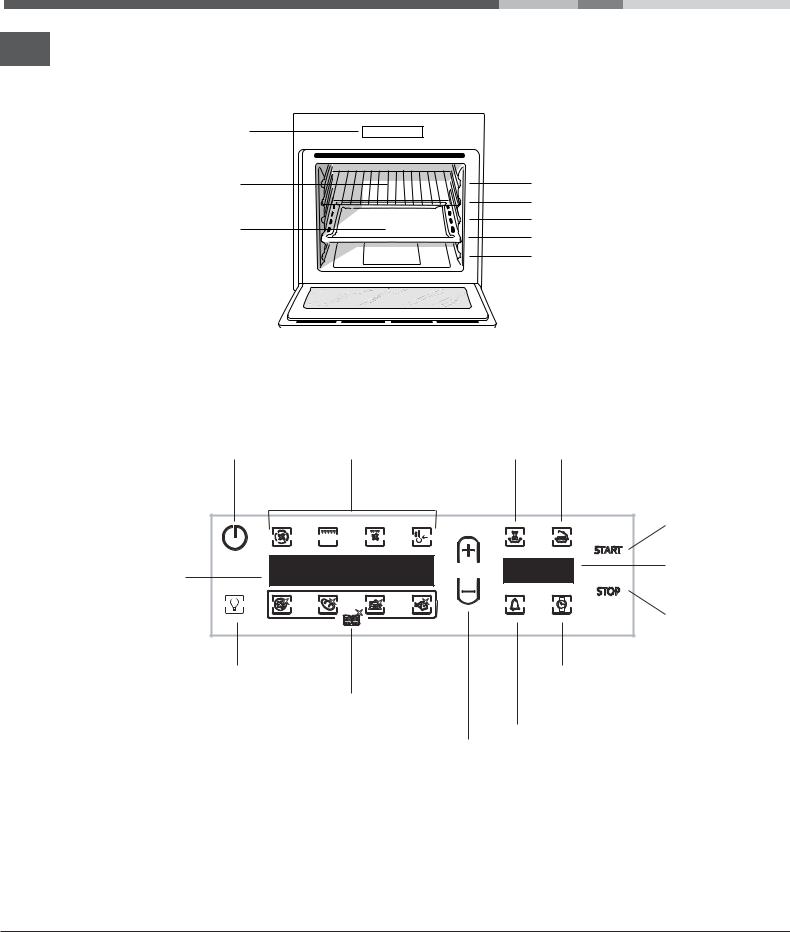
Description
of the appliance
Overall view
GB
Control panel |
GUIDES for the |
|
|
sliding racks |
|
GRILL |
position 5 |
|
|
position 4 |
|
DRIPPING PAN |
position 3 |
|
position 2 |
||
|
||
|
position 1 |
Control panel
CONTROL PANEL |
MANUAL |
DURATION |
COOKING END TIME |
POWER |
COOKING MODE |
icon |
icon |
button |
icons |
|
|
|
|
|
START |
TEMPERATURE |
|
|
TIME |
|
|
display |
|
display |
|
|
|
|
|
|
STOP |
OVEN |
|
AUTOMATIC |
CLOCK |
LIGHT |
|
COOKING |
icon |
icon |
|
MODE |
|
|
|
icons |
|
|
|
TIME/TEMPERATURE |
TIMER |
|
|
ADJUSTMENT |
icon |
|
|
buttons |
|
4

Start-up and use
The first time you use your appliance, heat the empty oven with its door closed at its maximum temperature for at least half an hour. Ensure that the room is well ventilated before switching the oven off and opening the oven door. The appliance may emit a slightly unpleasant odour caused by protective substances used during the manufacturing process burning away.
The “Control panel lock” and “DEMO mode” can be activated/deactivated even when the control panel is switched off.
Control panel lock
To lock the oven controls, press the and buttons simultaneously. A buzzer will sound and the TEMPERATURE display shows "Loc".
Press again to unlock the controls. The "STOP" button is always active.
Demo mode
The oven can operate in the DEMO mode: all heating elements are deactivated, and the controls remain operative.
To activate the DEMO mode, press the "+", , and "START" buttons simultaneously. A buzzer will sound and the TIME display shows "DEMO".
, and "START" buttons simultaneously. A buzzer will sound and the TIME display shows "DEMO".
To activate the DEMO mode, press the "+" and "START" buttons simultaneously. A buzzer will sound and the "DEMO" message disappears from the display.
Setting the clock and timer
After connection to the power supply network or after a
blackout, the button and the digits on the TIME display will flash.
To set the time:
1.Press buttons "+" and "-"; press and hold to scroll the numbers quicker and make setting easier.
2.Once the exact time is reached, wait 10 seconds for
the selection to be memorized, or press the  button again to fix the setting.
button again to fix the setting.
To make any necessary changes, switch off the control
panel by pressing the ; button, then press the  button and follow the steps indicated.
button and follow the steps indicated.
When the set time has elapsed, the timer emits a buzzer that will automatically stop after 6 seconds or when any active icon on the control panel is pressed.
To set the timer, press the  button and follow the
button and follow the
procedure used to set the clock. The  button switched on indicates that the timer has been activated.
button switched on indicates that the timer has been activated.
The timer does not switch the oven on or off.
GB
Starting the oven
1.Switch the control panel on by pressing the button.
2.Press the button corresponding to the desired cooking mode. The TEMPERATURE display shows the temperature of the cooking mode; the TIME display shows the current time.
3.Press the "START" button to begin cooking.
4.The oven will begin its preheating phase, the current temperature indicators will light up as the temperature rises. The temperature may be adjusted by pressing the "+" and "-" buttons.
5.When preheating is finished, a buzzer will sound and all current temperature indicators will be turned on: the food can then be placed in the oven.
6.During cooking it is always possible to:
-adjust the temperature by pressing the "+" and "-" buttons;
-set the duration of a cooking mode (see Cooking Modes);
-interrupt cooking by pressing the "STOP" button. 7. In case of a blackout, an automatic system will reactivate the cooking mode from where it was interrupted, provided the oven temperature has not dropped below a certain level. Programmed cooking
modes which have not started will not be restored and must be reprogrammed.
There is no preheating stage for the BARBECUE mode.
Never put objects directly on the bottom of the oven; this will avoid the enamel coating being damaged.
Always place cookware on the rack(s) provided.
Cooling ventilation
In order to cool down the external temperature of the oven, a cooling fan generates a stream of air which escapes between the oven control panel and the oven door.
Once the cooking has been completed, the cooling fan continues to operate until the oven has cooled down sufficiently.
Oven light
When the oven is not in operation, the lamp can be switched on at any time by pressing the button.
5
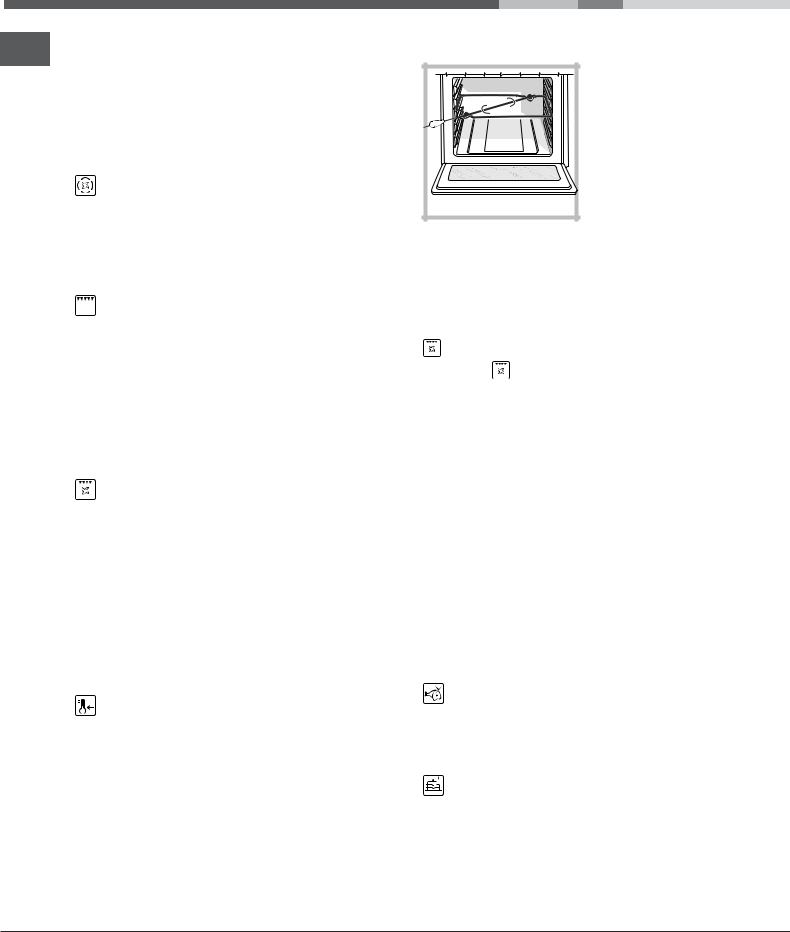
Cooking modes
Manual cooking modes
GB
All cooking modes have a default cooking temperature which may be adjusted manually between 40°C and 250°C as desired.
In the BARBECUE mode, the default power level value is indicated as a percentage (%) and may also be adjusted manually.
MULTILEVEL mode
All heating elements and the fan are activated. Since the heat remains constant throughout the oven, the air cooks and browns food in a uniform manner. A maximum of two racks may be used at the same time.
BARBECUE mode
The top heating element and the rotisserie spit (where present) are activated. By pressing the “+” and “-” buttons on the left hand side of the control panel, the power levels that may be set will appear on the TEMPERATURE display; these range between 5% and 100%. The high and direct temperature of the grill is recommended for food that requires high surface temperature. Always cook in this mode with the oven door closed.
GRATIN mode
The top heating element and the rotisserie spit (where present) are activated and the fan begins to operate. During part of the cycle the circular heating element is also activated. This combination of features increases the effectiveness of the unidirectional thermal radiation of the heating elements through forced circulation of the air throughout the oven.
This helps prevent food from burning on the surface and allows the heat to penetrate right into the food. Always cook in this mode with the oven door closed.
LOW TEMPERATURE modes
This type of cooking can be used for proving, defrosting, preparing yoghurt, heating dishes at the required speed and slow cooking at low temperatures. The temperature options are: 40, 65, 90 °C.
* Only on certain models.
Spit roast * |
To operate the rotisserie spit (see diagram) proceed as follows:
1.Place the dripping pan in position 1.
2.Place the rotisserie support in position 3 and insert the spit into the hole provided on the back panel of the oven.
3.Start the spit roast function by selecting the  or
or
modes.
When the mode is activated, the rotisserie spit will stop if the door is opened.
Automatic cooking modes
The temperature and cooking duration are pre-set values, guaranteeing a perfect result every time - automatically. These values cannot be adjusted and
use the C.O.P.® (Programmed Optimal Cooking) system. The cooking cycle stops automatically and the oven indicates when the dish is cooked. You may start cooking whether the oven has been
preheated or not.
When the cooking stage has been reached, the oven buzzer sounds.
Do not open the oven door as this will disrupt the duration and temperature.
MEAT mode
Use this function to cook beef, pork and lamb. Place the meat inside the oven while it is still cold. The dish may also be placed in a preheated oven.
 BAKED CAKES mode
BAKED CAKES mode
This function is ideal for cooking desserts which are made using natural yeast, baking powder and desserts which contain no yeast. Place the dish in the oven while it is still cold. The dish may also be placed in a preheated oven.
6

 PIZZA mode
PIZZA mode
Use this function to make pizza. Please see the following chapter for further details.
 BREAD mode
BREAD mode
Use this function to make bread. Please see the following chapter for further details.
 PIZZA mode
PIZZA mode
To obtain the best results, we recommend that you carefully observe the instructions below:
•Follow the recipe.
•The weight of the dough should be between 500 g and 700 g.
•Lightly grease the dripping pan.
Recipe for PIZZA:
1 dripping pan on a low shelf level, hot or cold oven Recipe for 3 pizzas weighing approximately 550 g: 1000 g flour, 500 ml water, 20 g salt, 20 g sugar, 100 ml olive oil, 20 g fresh yeast (or 2 sachets of powder yeast)
•Leavening at room temperature: 1 hour.
•Place inside hot or cold oven.
•Start the  PIZZA cooking mode.
PIZZA cooking mode.
BREAD mode |
GB |
|
To obtain the best results, we recommend that you |
||
|
||
|
||
carefully observe the instructions below: |
|
•Follow the recipe.
•Do not exceed the maximum weight of the dripping pan.
•Remember to pour 100 ml of cold water into the baking tray in position 5.
•The dough must be left to rise at room temperature for 1 – 1 ½ hours (depending on the room temperature) or until the dough has doubled in size.
Recipe for BREAD:
1 Dripping pan holding 1000 g Max, lower level
2 Dripping pans each holding 1000 g Max, medium and lower levels
Recipe for 1000 g of dough: 600 g flour, 360 g water, 11g salt, 25 g fresh yeast (or 2 sachets of powder yeast)
Method:
•Mix flour and salt in a large bowl.
•Dilute yeast in lukewarm water (approximately 35 degrees).
•Make a small well in the mound of flour.
•Pour in water and yeast mixture.
•Knead dough by stretching and folding it over itself with the palm of your hand for 10 minutes until it has a uniform consistency and is not too sticky.
•Form the dough into a ball shape, place it in a large bowl and cover it with transparent plastic wrap to prevent the surface of the dough from drying out. Select the manual LOW TEMPERATURE function on the oven and set the temperature to 40°C. Place the bowl inside and leave the dough to rise for approximately 1 hour (the dough should double in volume).
•Cut the dough into equal sized loaves.
•Place them in the dripping pan on oven paper.
•Cover the loaves with flour.
•Make incisions on the loaves.
•Remember to pour 100 ml of cold water into the baking tray in position 5. For cleaning purposes, we recommend the use of water and vinegar.
•Place the loaves inside the oven while it is still cold.
•Start the  BREAD cooking mode.
BREAD cooking mode.
•Once baked, leave the loaves on one of the grill racks until they have cooled completely.
7
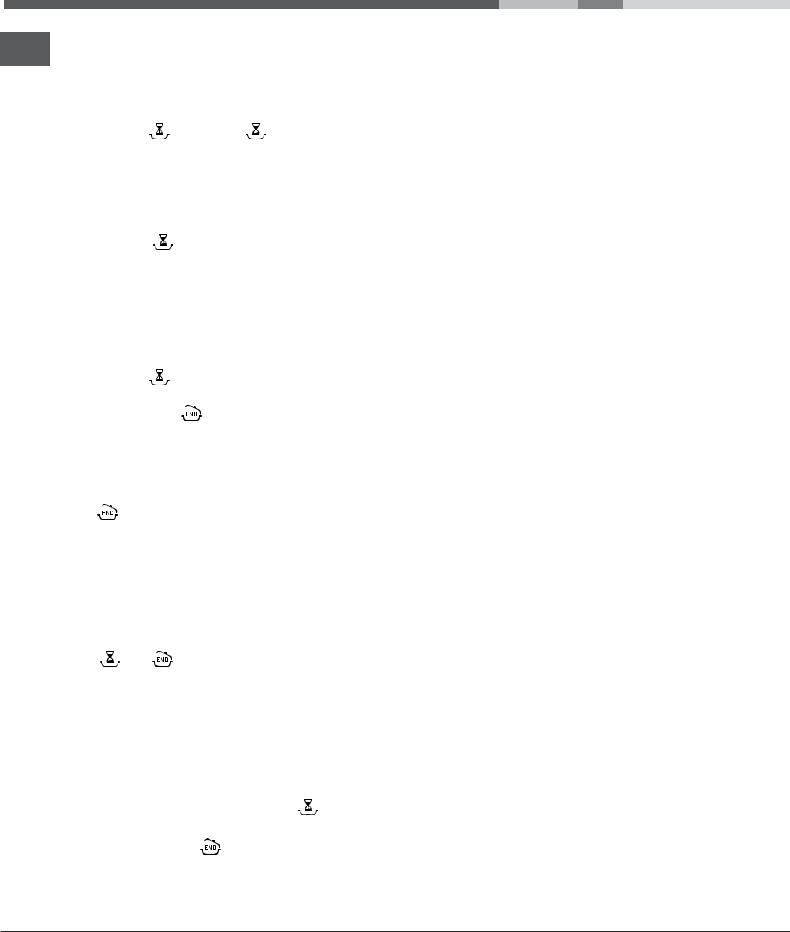
Programming cooking
GB
A cooking mode must be selected before programming can take place.
Programming the duration
1. Press the |
; button; the |
button and the |
numbers on the TIME display will flash.
2.To set the duration, press buttons "+" and "-"; press and hold to scroll the numbers quicker and make setting easier.
3.Once the desired duration setting is reached, wait
10seconds for the selection to be memorized, or
press button |
again to fix the setting. |
4. When the set time has elapsed, END appears on the TEMPERATURE display and a buzzer sounds.
•For example: it is 9:00 a.m. and a time of 1 hour and 15 minutes is programmed. The programme will stop automatically at 10:15 a.m.
Programming delayed cooking
1. Press the |
button and repeat steps 1 to 3 as |
|
described for the duration setting. |
||
2. Then press the |
button and set the end of |
|
cooking time by pressing buttons "+" and "-"; press and hold to scroll the numbers quicker and make setting easier.
3. Once the end of cooking time is reached, wait 10 seconds for the selection to be memorized, or press
the button again to fix the setting.
4.Press the “START” button to confirm the programming process.
5.When the selected time has elapsed, END appears on the TEMPERATURE display and a buzzer sounds.
• For example: it is 9:00 a.m. and a time of 1 hour and 15 minutes is programmed and the end time is set to 12:30. The programme will start automatically at 11:15 a.m.
The |
and |
buttons will flash signalling that the |
programmed mode has been set. After programming, in the time before cooking starts, the TIME display indicates the duration and end of cooking time alternately.
To cancel a programming procedure press the "STOP" button.
When selecting a cooking mode, the |
button is |
activated whereas the  button is not. When setting
button is not. When setting
the cooking time, the |
button is illuminated and |
delayed cooking can be programmed.
Practical cooking advice
Do not place racks in position 1 and 5 during fanassisted cooking. This is because excessive direct heat can burn temperature sensitive foods.
In the BARBECUE and GRATIN cooking modes, particularly when using the rotisserie spit, place the dripping pan in position 1 to collect cooking residues (fat and/or grease).
MULTILEVEL
•Use positions 2 and 4, placing the food which requires more heat on 2.
•Place the dripping pan on the bottom and the rack on top.
BARBECUE
•Place the grill rack in position 3 or 4 and place the food in the centre of the rack.
•We recommend that the power level is set to maximum. The top heating element is regulated by a thermostat and may not always operate constantly.
PIZZA
•Use a light aluminium pizza pan. Place it on the rack provided.
For a crispy crust, do not use the dripping pan as it prevents the crust from forming by extending the total cooking time.
•If the pizza has a lot of toppings, we recommend adding the mozzarella cheese on top of the pizza halfway through the cooking process.
8

Cooking advice table
GB
Cooking |
Foods |
Weight |
Rack position |
Preheating |
Recommended |
Cooking duration |
|
modes |
|
(in kg) |
|
|
|
temperature |
(minutes) |
|
|
|
|
|
|
(°C) |
|
|
|
|
standard |
sliding guide |
|
|
|
|
|
|
guide rails |
rails |
|
|
|
Multilevel* |
Pizza on 2 racks |
1+1 |
2 and 4 |
1 and 3 |
Yes |
220-230 |
20-25 |
|
Pies on two racks/cakes on 2 racks |
1 |
2 and 4 |
1 and 3 |
Yes |
180 |
30-35 |
|
Sponge cake on 2 racks (on the dripping pan) |
1 |
2 and 4 |
1 and 3 |
Yes |
170 |
20-25 |
|
Roast chicken + potatoes |
1 |
1 and 2/3 |
1 and 3 |
Yes |
200-210 |
65-75 |
|
Lamb |
|
2 |
1 |
Yes |
190-200 |
45-50 |
|
Mackerel |
|
1 or 2 |
1 |
Yes |
180 |
30-35 |
|
Lasagne |
|
2 |
1 |
Yes |
190-200 |
35-40 |
|
Cream puffs on 2 racks |
|
2 and 4 |
1 and 3 |
Yes |
190 |
20-25 |
|
Biscuits on 2 racks |
|
2 and 4 |
1 and 3 |
Yes |
190 |
10-20 |
|
Cheese puffs on 2 racks |
|
2 and 4 |
1 and 3 |
Yes |
210 |
20-25 |
|
Savoury pies |
|
1 and 3 |
1 and 3 |
Yes |
200 |
20-30 |
Barbecue* |
Mackerel |
1 |
4 |
3 |
No |
100% |
15-20 |
|
Sole and cuttlefish |
0.7 |
4 |
3 |
No |
100% |
10-15 |
|
Squid and prawn kebabs |
0.7 |
4 |
3 |
No |
100% |
8-10 |
|
Cod fillet |
0.7 |
4 |
3 |
No |
100% |
10-15 |
|
Grilled vegetables |
0.5 |
3 or 4 |
2 or 3 |
No |
100% |
15-20 |
|
Veal steak |
0.8 |
4 |
3 |
No |
100% |
15-20 |
|
Sausages |
0.7 |
4 |
3 |
No |
100% |
15-20 |
|
Hamburgers |
4 or 5 |
4 |
3 |
No |
100% |
10-12 |
|
Toasted sandwiches (or toast) |
4 or 6 |
4 |
3 |
No |
100% |
3-5 |
|
Spit-roast chicken using rotisserie spit (where present) |
1 |
- |
- |
No |
100% |
70-80 |
|
Spit-roast lamb using rotisserie spit (where present) |
1 |
- |
- |
No |
100% |
70-80 |
Gratin* |
Grilled chicken |
1.5 |
2 |
2 |
No |
210 |
55-60 |
|
Cuttlefish |
1 |
2 |
2 |
No |
200 |
30-35 |
|
Spit-roast chicken using rotisserie spit (where present) |
1.5 |
- |
- |
No |
210 |
70-80 |
|
Spit-roast duck using rotisserie spit (where present) |
1.5 |
- |
- |
No |
210 |
60-70 |
|
Roast veal or beef |
1 |
2 |
2 |
No |
210 |
60-75 |
|
Roast pork |
1 |
2 |
2 |
No |
210 |
70-80 |
|
Lamb |
1 |
2 |
2 |
No |
210 |
40-45 |
Low |
Defrosting |
|
2 or 3 |
2 |
No |
- |
- |
temperature |
Proving |
|
2 or 3 |
2 |
No |
- |
60-90 |
|
Dish heating |
|
2 or 3 |
2 |
No |
- |
- |
|
Pasteurisation |
|
2 or 3 |
2 |
No |
- |
- |
Automatic |
Pizza (see recipe) |
1 |
2 |
2 |
No |
- |
23-33 |
pizza |
Focaccia (bread dough) |
1 |
2 |
2 |
No |
- |
23-33 |
Automatic |
Bread (see recipe) |
1 |
2 |
2 |
No |
- |
55 |
bread |
|
|
|
|
|
|
|
Automatic |
Cakes made using leavened dough |
1 |
2 or 3 |
2 |
No |
- |
35-55 |
baked cakes |
|
|
|
|
|
|
|
Automatic |
Roasts |
1 |
2 or 3 |
2 |
No |
- |
60-80 |
roast |
|
|
|
|
|
|
|
* The cooking times listed above are intended as guidelines only and may be modified according to personal tastes. Oven preheating times are set as standard and may not be modified manually.
9

Precautions and tips
This appliance has been designed and
GB manufactured in compliance with international safety standards. The following warnings are provided for safety reasons and must be read carefully.
General safety
•The appliance was designed for domestic use inside the home and is not intended for commercial or industrial use.
•The appliance must not be installed outdoors, even in covered areas. It is extremely dangerous to leave the appliance exposed to rain and storms.
•When moving or positioning the appliance, always use the handles provided on the sides of the oven.
•Do not touch the appliance with bare feet or with wet or damp hands and feet.
•The appliance must be used by adults only for the preparation of food, in accordance with the instructions provided in this booklet.
•Do not touch the heating elements and parts of the oven door when the appliance is in use; these parts become extremely hot. Keep children well away from the appliance.
•Ensure that the power supply cables of other electrical appliances do not come into contact with the hot parts of the oven.
•The openings used for the ventilation and dispersion of heat must never be covered.
•Always grip the oven door handle in the centre: the ends may be hot.
•Always use oven gloves when placing cookware in the oven or when removing it.
•Do not use aluminium foil to line the bottom of the oven.
•Do not place flammable materials in the oven: If the appliance is switched on accidentally, it could catch fire.
•When unplugging the appliance, always pull the plug from the mains socket; do not pull on the cable.
•Never perform any cleaning or maintenance work without having disconnected the appliance from the electricity mains.
•If the appliance breaks down, under no circumstances should you attempt to perform the repairs yourself. Repairs carried out by inexperienced persons may cause injury or further malfunctioning of the appliance. Contact a Service Centre (see Assistance).
•Do not rest heavy objects on the open oven door.
•The appliance should not be operated by people (including children) with reduced physical, sensory or mental capacities, by inexperienced individuals or by anyone who is not familiar with the product. These individuals should, at the very least, be supervised by someone who assumes responsibility for their safety or receive preliminary instructions relating to the operation of the appliance.
•Do not let children play with the appliance.
Disposal
•When disposing of packaging material: observe local legislation so that the packaging may be reused.
•The European Directive 2002/96/EC relating to Waste Electrical and Electronic Equipment (WEEE) states that household appliances should not be disposed of using the normal solid urban waste cycle. Exhausted appliances should be collected separately in order to optimise the cost of re-using and recycling the materials inside the machine, while preventing potential damage to the atmosphere and to public health. The crossed-out dustbin is marked on all products to remind the owner of their obligations regarding separated waste collection.
For further information relating to the correct disposal of exhausted household appliances, owners may contact the public service provided or their local dealer.
Respecting and conserving the environment
•You can help to reduce the peak load of the electricity supply network companies by using the oven in the hours between late afternoon and the early hours of the morning. The cooking mode programming options, the “delayed cooking” mode (see Cooking modes) in particular, enable the user to organise their time efficiently.
•Always keep the oven door closed when using the BARBECUE and GRATIN modes: This will achieve improved results while saving energy (approximately 10%).
•Check the door seals regularly and wipe them clean to ensure they are free of debris so that they adhere properly to the door, thus avoiding heat dispersion.
10

Care and maintenance
Switching the appliance off
Disconnect your appliance from the electricity supply before carrying out any work on it.
Cleaning the appliance
•The stainless-steel or enamel-coated external parts and the rubber seals may be cleaned using a sponge that has been soaked in lukewarm water and neutral soap. Use specialised products for the removal of stubborn stains. After cleaning, rinse and dry thoroughly. Do not use abrasive powders or corrosive substances.
•The inside of the oven should ideally be cleaned after each use, while it is still lukewarm. Use hot water and detergent, then rinse well and dry with a soft cloth. Do not use abrasive products.
•All accessories can be washed like everyday crockery, and are even dishwasher safe.
•We recommend that detergents are not sprayed
directly onto the control panel, but that a sponge is used instead.
Never use steam cleaners or pressure cleaners on the appliance.
Cleaning the oven door
Clean the glass part of the oven door using a sponge and a non-abrasive cleaning product, then dry thoroughly with a soft cloth. Do not use rough abrasive material or sharp metal scrapers as these could scratch the surface and cause the glass to crack.
For more thorough cleaning purposes, the oven door may be removed:
1. Open the oven door fully (see diagram).
F |
Inspecting the seals
3. Grip the door on the two
external sides and close it GB approximately half way.
Unlock the door by pressing on the clamps F, then pull the door towards you, lifting it out of its slot (see diagram). To replace the door, reverse this sequence.
Check the door seals around the oven regularly. If the seals are damaged, please contact your nearest Aftersales Service Centre (see Assistance). We recommend that the oven is not used until the seals have been replaced.
Replacing the light bulb
To replace the oven light bulb:
1.Remove the glass cover using a screwdriver.
2.Remove the light bulb and replace it with a similar one: Wattage 15 W, cap E 14.
Replace the glass cover, making sure the seal is positioned correctly (see diagram).
F |
2. Lift up and turn the small levers located on the two hinges (see diagram).
11

Assistance
GB
Warning:
The appliance is fitted with an automatic diagnostic system which detects any malfunctions. Malfunctions are displayed by messages of the following type: “ER” followed by numbers.
Call for technical assistance should a malfunction occur.
Before calling for Assistance:
•Check whether you can fix the problem yourself.
•Restart the programme to check whether the malfunction has disappeared.
•If it has not, contact the Authorised Technical Assistance Service.
Never use the services of an unauthorised technician.
Please have the following information to hand:
•The message displayed on the TEMPERATURE display.
•The appliance model (Mod.).
•The serial number (S/N).
The latter two pieces of information can be found on the data plate located on the appliance.
12

Brugervejledning
OVN
|
|
|
|
|
|
|
|
|
|
|
|
|
|
|
|
|
Oversigt |
|
|
|
|
|
|
|
|
|
DK |
|
|
|
|
|
|
|
|
|
|
|
|
|
|
|
|
|
|
|
Installation, 14-15 |
|
|
|
|
|
|
|
|
|
|
|
|
|
GB |
|
DK |
|
NO |
|
Placering |
|
|
|
|
|
|
|
|
|
Elektrisk tilslutning |
|
|
|
|
|
|
|
|
|
|
||
|
English,1 |
Dansk, 13 |
Norsk,25 |
Typeskilt |
|
||||
FI SE
Suomi, 37 |
Svenska, 49 |
Beskrivelse af ovnen, 16
Samlet illustration Betjeningspanel
Start og brug, 17
Tastelås DEMO-tilstand
Indstilling af ur og minuttæller Sådan startes ovnen
Programmer, 18-21
FQ 1030.1 NE /HA
Manuelle tilberedningsprogrammer Automatiske tilberedningsprogrammer Programmering af tilberedning Praktiske råd til tilberedning
Skema over tilberedning
Forskrifter og råd, 22
Generelt om sikkerheden Bortskaffelse
Spar på energien og værn om miljøet
Vedligeholdelse, 23-24
Afbrydelse af strømmen Rengøring af apparatet Rengøring af ovndøren Udskiftning af pære Service

Installation
Det er vigtigt at opbevare dette hæfte et sted, så det DK nemt kan konsulteres. Hvis apparatet sælges,
overdrages eller flyttes, skal man sørge for, at brugervejledningen følger med, så den nye ejer kan få oplysninger om apparatets funktion og eventuelle advarsler.
Læs omhyggeligt instruktionerne: De indeholder vigtige oplysninger om installation, anvendelse og sikkerhed.
Placering
Emballagen må ikke betragtes som legetøj til børn, og den skal bortskaffes i henhold til bestemmelserne om sortering af affald (se afsnittet Forskrifter og råd).
Installationen skal udføres i overensstemmelse med instruktionerne og af en kvalificeret tekniker. En fejlagtig installation kan medføre personskade, skader på dyr samt materielle skader.
Indbygning
For at ovnen skal kunne fungere korrekt, skal indbygningsskabet være egnet dertil:
•Panelerne på skabene ved siden af ovnen skal være lavet af materialer, der er modstandsdygtige over for varme.
•På skabe af finerplader skal limen være modstandsdygtig over for temperaturer på 100º C.
•Hvis ovnen indbygges i et skab, både ved montering under en bordplade (se figuren) og ved søjleopbygning, skal skabet have følgende mål:
23 mm. 5 mm.
595 mm.
567 mm.
|
|
|
|
|
. |
|
|
|
|
in |
|
|
|
|
.m |
|
|
|
|
m |
|
|
|
|
7m |
|
|
|
|
4 |
|
|
|
|
|
5 |
|
|
|
|
|
|
|
|
|
. |
|
45 |
mm |
|
|||
|
|
|
|
||
|
|
558 |
mm. |
||
|
|
|
|
||
593 mm.
595 |
|
m |
|
mm. |
. |
|
m |
|
|
|
545 |
|
. |
|
|
m |
|
|
m |
|
24 |
|
|
Når ovnen er blevet indbygget, må der ikke være mulighed for eventuelt kontakt med de elektriske dele. Oplysningerne om energiforbrug, angivet på typeskiltet, er målt på denne type installation.
Ventilation
For at sikre en god ventilation, er det nødvendigt at afmontere den bageste væg på indbygningsskabet. Det tilrådes at installere ovnen, så den støtter på to trælister eller på en plan overflade med en åbning på minimum 45 x 560 mm (se figuren).
. |
45 |
mm |
|
m |
|
. |
|
m |
|
|
|
560 |
|
|
|
Centrering og fastgørelse
Placér de 4 stifter på siden af ovnen ud for de 4 huller på omkredsrammen, idet der tages hensyn til køkkenelementets tykkelse:
Tykkelse på 20 mm: Fjern den bevægelige del af den udragende stift (se figuren).
Tykkelse på 18 mm: Brug den første rille, som allerede findes ved levering fra fabrikken (se
figuren).
Tykkelse på 16 mm: Brug den anden rille (se figuren).
Sådan fastgøres ovnen til køkkenelementet: Åbn ovndøren, og skru de 4 skruer i de 4 passende huller på omkredsrammen.
Alle sikkerhedsdele skal være monteret på en sådan måde, at de ikke kan fjernes uden brug af værktøj.
14
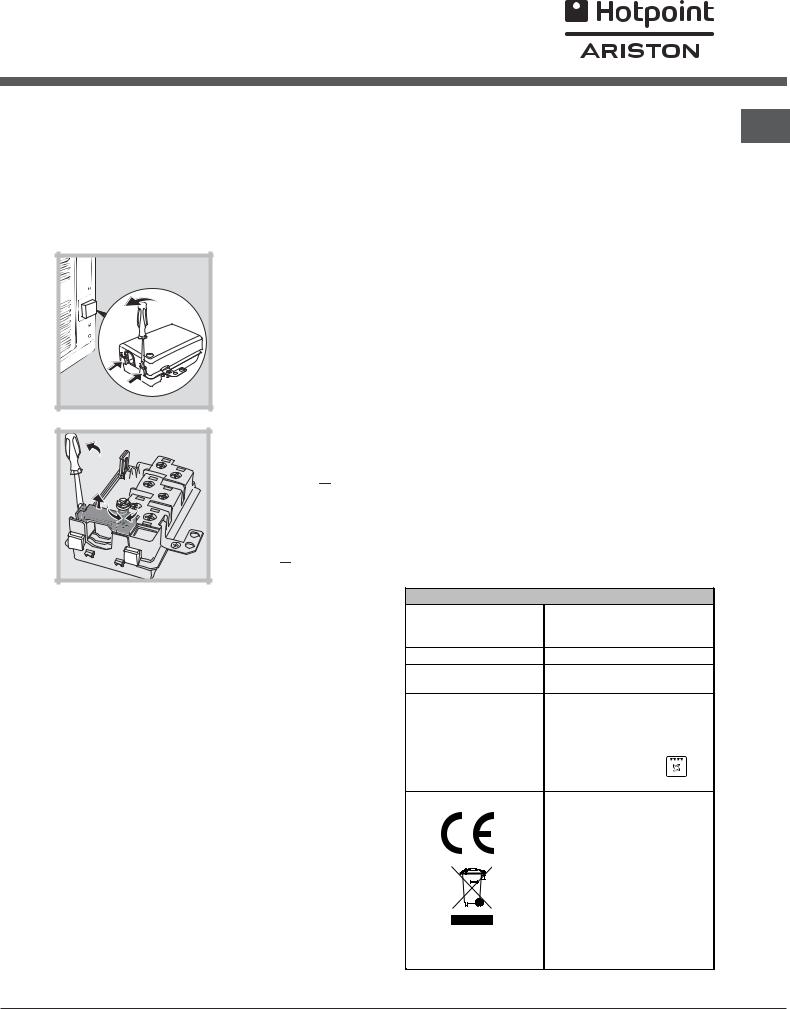
Elektrisk tilslutning
Ovne, der er udstyret med et trepolet forsyningskabel er klargjort til funktion med vekselstrøm ved den spænding og frekvens, der er anført på ovnens typeskilt (se herunder).
Montering af forsyningskabel
1. Åbn klemrækken ved at stikke en skruetrækker ned i klapperne på siden af dækslet. Træk og åbn dækslet (se figuren).
2. Løsn skruen i kabelklemmen, og tag den ud ved at vrikke skruetrækkeren (se
figuren).
3. Tag skruerne af kontakterne L-N- og fastgør de små ledninger under skruehovederne i overensstemmelse med farverne Blå (N) Brun (L) Gulgrøn (
og fastgør de små ledninger under skruehovederne i overensstemmelse med farverne Blå (N) Brun (L) Gulgrøn ( ).
).
Tilslutning af strømforsyningskablet til nettet
Anvend et standardstik på kablet til den belastning, der er anført på typeskiltet (se her ved siden af). Hvis man ønsker en direkte forbindelse til el-nettet, skal man indsætte en flerpolet afbryder med en minimumsåbning mellem kontakterne på 3 mm. i overensstemmelse med belastningen og i overensstemmelse med de gældende regler (der skal ikke være en afbryder på jordforbindelsen). Forsyningskablet skal være placeret på en sådan måde, at det ikke når en temperatur på 50º C over omgivelsestemperaturen på noget punkt.
Installatøren er ansvarlig for en korrekt elektrisk tilslutning samt overholdelse af sikkerhedsreglerne. Inden tilslutningen udføres, skal man kontrollere følgende:
•at stikkontakten har jordforbindelse og er i overensstemmelse med loven,
• at stikkontakten kan bære apparatets maksimale spændingsbelastning, som angivet på typeskiltet DK
(se herunder),
•at forsyningsspændingen ligger inden for værdierne, som angivet på typeskiltet (se herunder),
•at stikkontakten passer til apparatets stik. I modsat fald skal man udskifte stikkontakten eller stikket. Undgå anvendelse af forlængerledninger eller flerdobbelte stikdåser.
Når apparatet er installeret, skal man nemt kunne nå ind til både ledning og stikkontakt.
Ledningen må ikke bøjes eller trykkes sammen.
Ledningen skal regelmæssigt kontrolleres og må kun udskiftes af autoriserede teknikere (se afsnittet
Service).
Virksomheden fralægger sig ethvert ansvar, såfremt disse regler ikke overholdes.
TYPESKILT
Mål |
bredde 43,5 cm |
|
højde 32 cm |
||
|
dybde 41,5 cm |
|
Volumen |
lt. 58 |
|
Elektriske tilslutninger |
spænding 220-240V ~ 50Hz / |
|
maks. optaget effekt 2800W |
||
|
||
|
Direktiv 2002/40/EF på de |
|
|
elektriske ovnes etikette |
|
ENERGIMÆRKNING |
Standarden EN 50305. |
|
Energiforbrug forceret |
||
|
luftcirkulation - |
|
|
opvarmningsfunktion |
|
|
Gratin. |
|
|
Dette apparat er i |
|
|
overensstemmelse med |
|
|
følgende EU-direktiver: |
|
|
2006/95/EØF af 12/12/06 |
|
|
(Lavspænding) og |
|
|
efterfølgende ændringer - |
|
|
89/336/EØF af 03/05/89 |
|
|
(Elektromagnetisk |
|
|
kompatibilitet) og |
|
|
efterfølgende ændringer - |
|
|
93/68/EØF af 22/07/93 og |
|
|
efterfølgende ændringer. |
|
|
2002/96/EF |
15
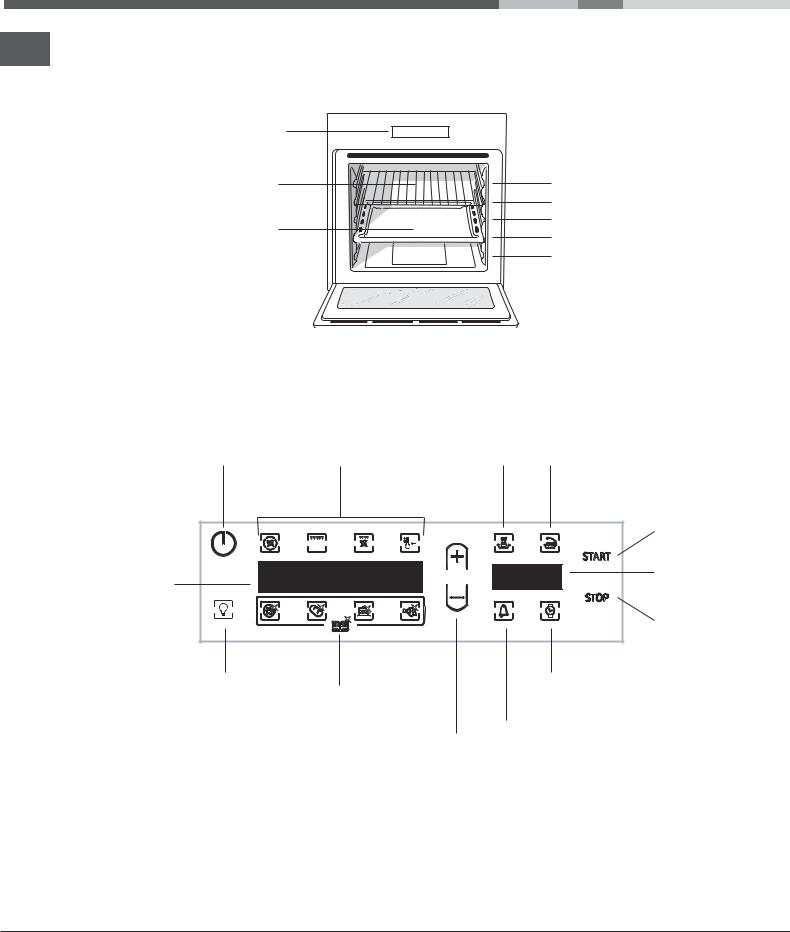
Beskrivelse af ovnen
Samlet illustration
DK
Betjeningspanel |
GLIDESKINNER |
|
|
til pladerne |
|
RIST |
rille 5 |
|
|
rille 4 |
|
BRADEPANDE |
rille 3 |
|
rille 2 |
||
|
||
|
rille 1 |
Betjeningspanel
TÆND PANEL |
Ikoner for |
Ikon for |
Ikon for |
|
MANUELLE |
VARIGHED |
AFSLUTNING AF TILBEREDNING |
|
PROGRAMMER |
|
|
|
|
|
T D |
Displayet |
|
|
Displayet |
|
|
TID |
|
TEMPERATUR |
|
|
|
|
|
|
|
|
Ikon for |
Ikoner for |
Ikon for |
|
OVNLYS |
AUTOMATISKE |
UR |
|
|
PROGRAMMER |
|
Taster til |
Ikon for |
ÆNDRING AF |
MINUTTÆLLER |
TIDSINDSTILLING/TEMPERATUR |
|
16

Start og brug
Når ovnen tændes første gang, anbefales det at lade ovnen være i funktion i tom tilstand i mindst en time med termostaten indstillet på maksimum og ovndøren lukket. Herefter skal man åbne ovndøren og udlufte lokalet. Lugten, der opstår, skyldes fordampning af beskyttelsesmidlerne i ovnen.
“Tastelås” og “DEMO-tilstand” kan aktiveres/ deaktiveres, selv om betjeningspanelet er slukket.
Tastelås
For at låse betjeningstasterne til ovnen skal man
trykke samtidig på tasterne og . Der udsendes et lydsignal, og displayet TEMPERATUR viser meddelelsen "Loc".
Tryk igen for at annullere tastelåsen. Tasten "STOP" forbliver hele tiden aktiveret.
Demo-tilstand
Ovnen kan køre i DEMO-tilstand. Alle varmeelementer deaktiveres og kun betjeningsknapperne fungerer.
For at aktivere DEMO-tilstand, skal man trykke samtidig på tasterne "+", , og "START". Der udsendes et lydsignal, og displayet TID viser meddelelsen "dEMO".
, og "START". Der udsendes et lydsignal, og displayet TID viser meddelelsen "dEMO".
For at deaktivere DEMO-tilstand, skal man trykke samtidig på tasterne "+" og "START". Der udsendes et lydsignal, og meddelelsen "dEMO" forsvinder.
Indstilling af ur og minuttæller
Efter tilslutning til strømforsyningen eller efter en
strømafbrydelse, blinker tasten  og cifrene på displayet TID.
og cifrene på displayet TID.
Sådan indstilles timetallet:
1.Tryk på tasterne "+" og "-". Hvis man holder tasterne nede, skifter tallene hurtigere, så indstillingen gøres nemmere.
2.Når det rette timetal er indstillet, skal man vente
10sek. for at gemme indstillingen eller trykke igen
på tasten  . Hvis uret skal opdateres, skal man slukke for betjeningspanelet ved at trykke på tasten
. Hvis uret skal opdateres, skal man slukke for betjeningspanelet ved at trykke på tasten
. Tryk derefter på tasten  og følg den beskrevne fremgangsmåde.
og følg den beskrevne fremgangsmåde.
Når tiden er udløbet, udsender minuttælleren et lydsignal, som slukker efter 6 sekunder, eller ved tryk på et vilkårligt aktivt ikon.
For at indstille minuttælleren skal man trykke på tasten  og følge fremgangsmåden for indstilling af
og følge fremgangsmåden for indstilling af
uret. Hvis tasten  lyser, angiver det, at minuttælleren er indstillet.
lyser, angiver det, at minuttælleren er indstillet.
Minuttælleren styrer ikke tænding og slukning af |
DK |
ovnen. |
Sådan tændes for ovnen
1. Tænd for betjeningspanelet ved at trykke på
tasten .
2.Tryk på tasten for det ønskede tilberedningsprogram. Displayet TEMPERATUR viser den tildelte temperatur til programmet. Displayet TID viser klokkeslættet.
3.Tryk på tasten "START" for at begynde tilberedningen.
4.Ovnen starter forvarmningsfasen, og temperaturlamperne tænder i takt med at temperaturen stiger. Det er muligt at ændre den indstillede temperatur ved at trykke på tasterne "+" og "-".
5.Der udsendes et lydsignal, og alle indikatorer for aktuel temperatur lyser, når forvarmningsfasen er fuldført. Sæt maden i ovnen.
6.Under tilberedningen er det altid muligt at:
-ændre temperaturen ved tryk på tasterne "+" og "-",
-indstille tilberedningstiden (se afsnittet
Programmer),
- afbryde tilberedningen ved tryk på tasten "STOP". 7. I tilfælde af strømafbrydelse, og hvis ovnens temperatur ikke er faldet for meget, er ovnen udstyret med et system til genoptagelse af programmet fra det punkt, hvor det blev afbrudt. Hvis der er indstillet til forsinket start, gemmes indstillingen dog ikke, og man skal foretage indstillingen igen, når strømmen vender tilbage.
Der udføres ingen forvarmning i programmet BARBECUE.
Undgå at placere genstande i bunden af ovnen, da det kan beskadige ovnens lakering.
Placér altid beholderne på den medfølgende rist.
Afkølingsventilation
For at reducere den udvendige temperatur skaber afkølingsblæseren en luftstrøm, der ledes ud mellem betjeningspanelet og ovndøren.
Ved afsluttet tilberedning fortsætter blæseren med at være tændt, indtil ovnen er passende afkølet.
Ovnlys
Selvom ovnen er slukket, kan man til enhver tid tænde for lyset ved at trykke på tasten.
17
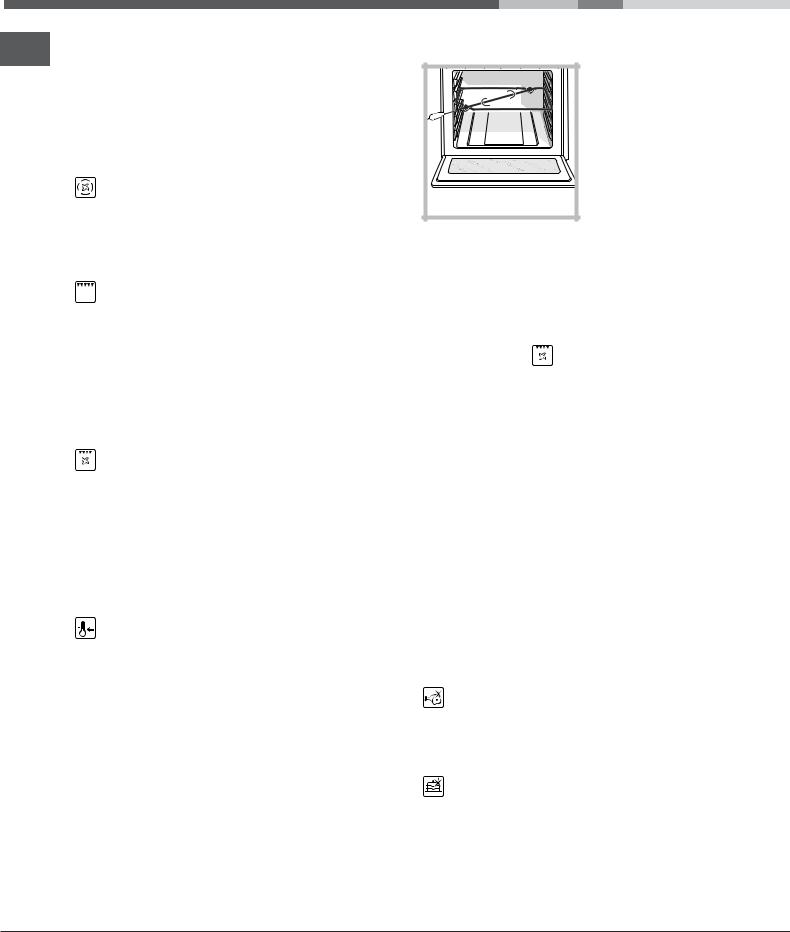
Programmer
Manuelle tilberedningsprogrammer
DK
Alle programmer har en forudindstillet tilberedningstemperatur. Den kan indstilles manuelt til mellem 40° C og 250° C.
I programmet BARBECUE er den forudindstillede værdi en effekt angivet i %. Den kan også indstilles manuelt.
Programmet VARMLUFT Varmeelementerne tændes, og blæseren starter. Da varmen er konstant og jævn i hele ovnen, tilbereder og
steger luften maden jævnt overalt. Der kan maks. anvendes to plader samtidig.
ProgrammetBARBECUE
Det øverste varmeelement tændes, og drejeindretningen starter (hvis monteret). Ved tryk på tasterne “+” og “-” til venstre, viser displayet TEMPERATUR de indstillelige effektniveauer, der går fra 5 % til 100 %. Det anbefales at anvende grillfunktionen med en højere og mere direkte temperatur til madvarer, der kræver en høj overfladetemperatur. Udfør tilberedningen med ovndøren lukket.
Programmet GRATINERING
Det øverste varmeelement tænder, og under opvarmningen tændes også det runde varmeelement. Både blæseren og drejespidet (hvis monteret) starter. Denne funktion forener den ensrettede varmeudsendelse med forceret luftcirkulation i ovnen. Dette forhindrer forbrænding af overfladen på maden, således at varmeindtrængningen bliver større. Udfør tilberedningen med ovndøren lukket.
Programmet LAV TEMPERATUR
Denne type tilberedning er velegnet til hævning og optøning af madvarer samt til fremstillelse af yoghurt og til hurtig eller langsom opvarmning. Der kan vælges mellem følgende temperaturer: 40, 65, 90°C.
Drejeindretning (kun på nogle modeller)
Benyt følgende fremgangsmåde (se figuren) for at starte drejeindretningen:
1.Placér bradepanden i rille 1.
2.Placér grillspydets holder i rille 3, og indsæt spiddet i hullet bagest i ovnen.
3.Start drejeindretningen ved at vælge programmerne
 eller
eller .
.
Hvis programmet er tændt og døren åbnes, standser drejeindretningen.
Automatiske tilberedningsprogrammer
Temperatur og tilberedningsvarighed er forudindstilletog kan ikke ændres ved hjælp af systemet C.O.P.® (Programmeretoptimal tilberedning), som automatisk sikrer et perfekt resultat. Tilberedningen afbrydes automatisk, og ovnen udsender et signal, når maden er klar. På denne tilberedningsfunktion kan maden både sættes i en kold eller en varm ovn.
Når ovnens tilberedningsfase er nået, udsendes et lydsignal.
Undgå at åbne ovndøren, så tilberedningstiden og temperaturen ikke ændres.
Programmet KØD
Brug denne funktion til tilberedning af kalvekød, svinekød og lammekød. Sæt maden i en kold ovn Maden kan også sættes i en varm ovn.
Programmet BAGVÆRK
Denne funktion er ideel til tilberedning af bagværk med enten gær eller med bagepulver og uden gær. Maden sættes i en kold ovn. Maden kan også sættes i en varm ovn.
18
